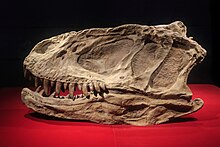斑龙科
| 斑龙科 | |
|---|---|

| |
| 蛮龙的骨架,位于古代生命博物馆 | |
| 科学分类 | |
| 界: | 动物界 Animalia |
| 门: | 脊索动物门 Chordata |
| 纲: | 蜥形纲 Sauropsida |
| 总目: | 恐龙总目 Dinosauria |
| 目: | 蜥臀目 Saurischia |
| 亚目: | 兽脚亚目 Theropoda |
| 演化支: | 新兽脚类 Neotheropoda |
| 演化支: | 鸟吻类 Averostra |
| 演化支: | 坚尾龙类 Tetanurae |
| 演化支: | 俄里翁龙类 Orionides |
| 总科: | †斑龙总科 Megalosauroidea |
| 演化支: | †斑龙类 Megalosauria |
| 科: | †斑龙科 Megalosauridae Huxley, 1869 |
| 模式种 | |
| †巴氏斑龙 Megalosaurus bucklandi Mantell , 1827
| |
| 演化支 | |
| 异名 | |

斑龙科(Megalosauridae)又名巨龙科、巨齿龙科,是兽脚亚目坚尾龙类的一科,属于蜥臀目。它们是群肉食性恐龙,体型范围从小到大,拥有锐利的牙齿,每个手掌有3个指爪。著名的物种包括:斑龙、美扭椎龙、扭椎龙、以及蛮龙。斑龙科仅存活于侏罗纪中期到晚期,化石发现于目前的欧洲、北美洲、南美洲、以及非洲等地。斑龙科被大多数研究人员,例如塞里诺、奥利舍夫斯基、霍尔兹…等人,认为是棘龙科的近亲。
分类学
[编辑]汤玛斯·亨利·赫胥黎(Thomas Henry Huxley)在1869年建立了斑龙科与斑龙。斑龙科长久以来被当成垃圾箱类群,包括许多没有亲缘关系的属,例如:伤龙、角鼻龙、印度龙、甚至伶盗龙。因为斑龙科传统上被当成复系群使用,因此包含保罗·塞里诺在内的许多科学家,改而采用蛮龙科(Torvosauridae,由詹姆斯·詹森在1985年建立);但根据国际动物命名委员会的规定,斑龙科仍拥有优先权[1]。因为同种原因,塞里诺与其他科学家也改而采用斑龙超科,而不采用棘龙超科[1]。在2008年,R.B.J. Benson等人认为斑龙与其他兽脚类恐龙的关系无法确定,而某些被归类于斑龙科的原始棘龙类不应被归类于此科中[2]。在2010年,R.B.J. Benson等人再度研究斑龙,并提出斑龙科的种系发生学研究[3]。
系统发生学
[编辑]在2002年,R. Allain提出斑龙科的第一个系统发生学研究,范围是:迪布勒伊洛龙(Dubreuillosaurus)、蛮龙、非洲猎龙的最近共同祖先,以及其最近共同祖先的所有后代[4]。在2004年,托马斯·霍尔特(Thomas R. Holtz Jr)等人提出新的定义:恐龙之中,所有接近斑龙,而离棘龙、异特龙、家麻雀较远的所有物种[5]。在2005年,保罗·塞里诺(Paul Sereno)认为斑龙的化石过去破碎,反对使用斑龙科,而改用蛮龙科,并将蛮龙科的定义为:恐龙之中,所有接近蛮龙,而离棘龙、异特龙、家麻雀较远的所有物种[1]。
以下演化树是根据R. Allain在2002年的研究[4]:
| 斑龙科 |
| ||||||||||||||||||
以下演化树根据2010年的R.B.J. Benson等人的种系发生学研究[3][6]:
| 斑龙科 |
| |||||||||||||||||||||||||||||||||||||||
参考资料
[编辑]- ^ 1.0 1.1 1.2 Sereno, P.C. (2005). Stem Archosauria—TaxonSearch 互联网档案馆的存档,存档日期2009-01-15. [version 1.0, 2005 November 7]
- ^ Benson R.B.J., Barrett P.M., Powell H.P., Norman D.B. The taxonomic status of Megalosaurus bucklandii (Dinosauria, Theropoda) from the Middle Jurassic of OxfordshireE, UK.. Palaeontology. 2008, 51 (2): 419–424. doi:10.1111/j.1475-4983.2008.00751.x.
- ^ 3.0 3.1 Benson, R.B.J. A description of Megalosaurus bucklandii (Dinosauria: Theropoda) from the Bathonian of the UK and the relationships of Middle Jurassic theropods. Zoological Journal of the Linnean Society. 2010, 158: 882. doi:10.1111/j.1096-3642.2009.00569.x.
- ^ 4.0 4.1 Allain R. Discovery of megalosaur (Dinosauria, Theropoda) in the middle Bathonian of Normandy (France) and its implications for the phylogeny of basal Tetanurae. Journal of Vertebrate Paleontology. 2002, 22 (3): 548–563. doi:10.1671/0272-4634(2002)022[0548:DOMDTI]2.0.CO;2.
- ^ Holtz, T.R., Molnar, R.E., Currie, P.J. (2004). "Basal Tetanurae." In Weishampel, D.B., Dodson, P., & Osmolska, H. (Eds.). The Dinosauria (2nd Edition). Berkeley: University of California Press. Pp. 71-110.
- ^ Benson, R.B.J., Carrano, M.T and Brusatte, S.L. A new clade of archaic large-bodied predatory dinosaurs (Theropoda: Allosauroidea) that survived to the latest Mesozoic. Naturwissenschaften. 2010, 97 (1): 71–78. Bibcode:2010NW.....97...71B. PMID 19826771. doi:10.1007/s00114-009-0614-x. Supporting Information[永久失效链接]















